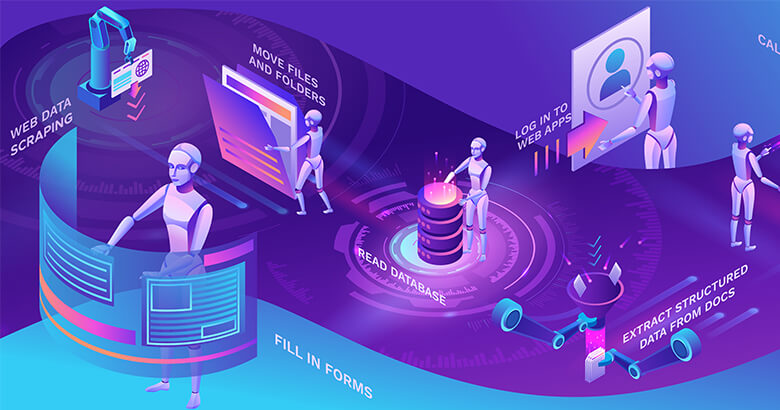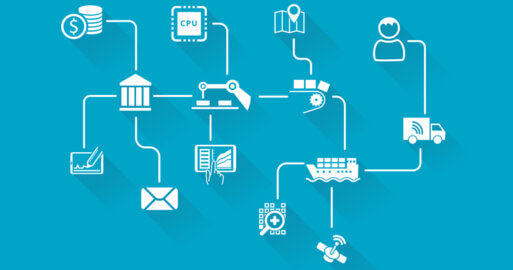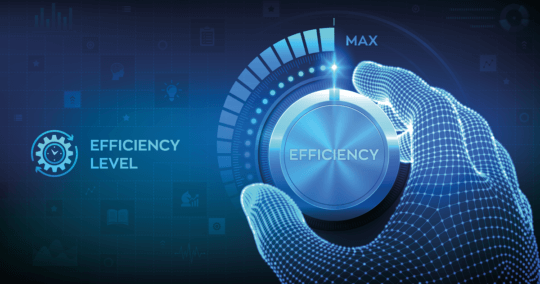Robotic Process Automation: What It Is, What It Does and What Are the Alternatives?

Imagine a world where repetitive, mundane business tasks are a thing of the past. Completing forms. Data entry. Cross-referencing invoices, sales orders, purchase orders and records for incoming goods. Payroll activities, where the values are different from month to month but the process is always the same – for every single employee.
Many businesses have been turning to Robotic Process Automation (RPA) to automate the above tasks. The intended advantages are clear; more time to dedicate to core business, lower personnel costs, greater job satisfaction.
However, is RPA the only way to achieve those goals? Is it the most effective way to automate and streamline your business?
In this article, we’ll be taking a closer look at Robotic Process Automation and comparing it to some alternatives.
Why automate repetitive, mundane business tasks?
According to a Korn Ferry poll 1 of nearly 5,000 professionals, the top reason people look for a new job is boredom. However, apart from the effect on staff motivation, there is a financial implication to your employees spending time on repetitive tasks. A 2018 survey of 721 sales representatives 2 discovered that respondents spent nearly 65% of their time on non-sales tasks. At the time, the average sales rep was paid an average of $105,482 a year. This meant that they were being paid $68,352 per year for non-selling tasks.
Anthony J. Stieber 3 has calculated that:
“Any daily work task that takes 5 minutes will cost over 20 hours a year, or over half of a work week. Even if it takes 20 hours to automate that daily 5-minute task, the automation will break even in a year.”
Many businesses have been turning to Robotic Process Automation (RPA) to automate repetitive, mundane tasks. Valued at USD 2.3 billion in 2022, it’s a strongly growing market, projected to expand at a compound annual growth rate (CAGR) of 39.9% from 2023 to 2030 4.
What is RPA?
Robotic process automation, RPA for short, conjures up some lovely pictures. Rows of robots, sitting at computer terminals and diligently doing your work for you. Unfortunately, there will be no metallic androids joining your company any time soon.
Instead, robotic process automation is about automating computer-based tasks that follow a predefined process. If you have a task that always follows the same steps, you could probably programme an RPA bot to do it for you. Front-end based, these bots work at software level, navigating through user interfaces and mimicking the clicks and steps that a human operator would make. You can even see it happening on the screen in front of you, albeit at breakneck speed.
What are the advantages of RPA?
The real magic of RPA lies in its robotic nature. RPA bots are tireless, working 24/7 without holidays or overtime pay. They complete tasks with remarkable speed, accuracy and consistency, reducing the risk of errors that plague manual processes. How does a company benefit from this? While the increased productivity and improved data quality lead directly to cost savings, they also free up employees to focus on more strategic, value-added activities.
What is RPA used for?
RPA is a versatile approach, finding applications in data retrieval, legacy system connectivity, form-filling, and more. Some RPA tools even offer coding capabilities programming in languages like Python, C#, or VBScript. This lets you write “if-then” statements, enabling bots to handle more complex tasks like processing emails, creating reports, or extracting data from scanned documents.
What added value does RPA bring?
As well as speeding up repetitive tasks, RPA software maintains a detailed audit trail of actions performed by the bots. This data could be valuable for compliance and security purposes.
These logs also contain invaluable big data for process analysis, measuring performance, and identifying areas for further optimization.
Furthermore, because RPA is non-intrusive, meaning it works on a software level and doesn’t need access to any back-end processes, it can often be used across multiple existing systems and applications without the need for major IT infrastructure changes. This means organizations can start automating processes without disrupting their current technology landscape, and scale relatively easily.
What are the challenges and limitations of RPA?
RPA bots follow strict rules, and any changes in processes, interfaces or underlying systems require reprogramming. Otherwise, they simply don’t work. This ongoing maintenance can be time-consuming and costly. Managing a multitude of bots and their updates is also a daunting task, which can quickly get out of hand if trying to scale up operations. How do you keep track of the many programmed bots and when they need updating? Who is responsible for these updates, and what happens if they leave the company?
Furthermore, RPA often needs to interface with multiple applications, including legacy systems. Although this may work initially, as the systems get older compatibility and security issues will only increase. As RPA works on a surface level with no deep integration, each incompatibility will require an ever more convoluted workaround. And, as a workaround becomes more convoluted, it not only needs more computing power (which has implications for sustainability and costs), it is also becomes more prone to errors.
So, is there a more efficient alternative?
What are the alternatives to RPA?
Enter APIs and integration platforms. APIs (Application Programming Interfaces) allow different software applications to communicate and exchange data. Integration platforms, like the SEEBURGER BIS Platform, simplify the process further with API management capabilities, automatic data conversion and seamless end-to-end data flow through deep integration and ready-to-use, configurable components for every type of user to automate data transfer, business processes and partner and customer onboarding.
What is an API?
An Application Programming Interface, API for short, is a set of rules and protocols that allows one software application to communicate with and request services or data from another application. It’s essentially a bridge, allowing one system – the caller – to request data or services from defined endpoints in the second system that software engineers have opened up for this purpose.
How do APIs compare to RPA?
Whereas both technologies can be used for connecting to and retrieving data from another system, APIs are faster than RPA bots, capable of providing data or services in real time. They are also more secure, employing security measures such as gateways, authentication keys and tokens. Unlike RPA bots, which just stop or circle when they encounter an error, APIs are also able to provide real-time error codes, alerting the user to a non-completed process and giving some insight as to why this has failed. As APIs take a more direct approach to data retrieval, they are not affected by cosmetic changes to a system or even a change in process. This direct approach means they often require considerably less computing power than an RPA bot, which has implications both for a company’s carbon footprint and its bottom line.
APIs can be used to communicate with cloud-based software, online services, and – by using an API wrapper – even with an in-house legacy system.
Their use is becoming ubiquitous in both the business and leisure worlds. This means that, just like for RPA bots, it is essential to keep track of them. Fortunately, this can be easily done with API management software.
What is API management?
In its simplest iteration, API management is a solution which lets you keep track of the APIs your company uses and provides for external parties in a catalogue. It helps you ensure that their security credentials are up to date and alerts you to any vulnerabilities.
Some API management capabilities, such as those on the BIS Platform, let you create APIs for programmes that do not natively support this capability.
How can an integration platform help you get the most out of your APIs?
The API management capabilities on the BIS draw on the integration and conversion capabilities on the integration platform to more easily create APIs for legacy applications – including on-premises installations – that do not natively support this capability. Instead of having to deal with complex programming issues like creating an API wrapper, the BIS supports any-to-any conversion, has a repository of thousands of prebuilt connectors and a team of dedicated developers to let you create an API to any application you require.
How is an integration platform a better alternative to RPA?
Whereas the great attraction of RPA is its non-intrusive nature, making it reasonably quick and easy to implement, remember the proverb that “a stitch in time saves nine”. Rather than working on surface level, an integration platform such as the BIS uses deep integration. Although there is a greater initial outlay to implement an integration platform – of time and money – the deep integration enables seamless end-to-end processes that are not affected by tweaks to interfaces or processes.
Indeed, SEEBURGER research on process mining discovered that processes rarely actually follow the theory, but contain a number of minor and major deviations. Whereas this is a problem for robotic process automation, an integration platform gets data flowing between applications regardless of the processes they are involved in.
This initial outlay is also worthwhile when it comes to scaling up operations. Whatever capability you begin with, once you have installed the BIS, you’re prepared for any challenge, with the flexibility to add capabilities as needed. You may wish to securely transfer large masses of data between applications using the managed file transfer capabilities. Instead of programming RPA bots to prepare business documents, you may wish to unlock the EDI capabilities to automate the creation and exchange of documents such as quotations, orders, shipping notifications and invoices. This even includes cross checking and validation functions, putting yet another RPA bot out of work. Or, how about fully automating your invoicing with the e-invoicing capabilities on the BIS Platform?
How does an e-invoicing compare to accounts automation with RPA?
RPA is often used within the accounting process to automate tasks like data entry, extracting information from documents, and transferring data between applications. Conversely, an e-invoicing package is a comprehensive solution which covers the entire invoicing process from generation to delivery to payment to processing and reporting the payment. It sends the information from the invoice as structured data, meaning that accounting programmes and tax reporting systems can automatically process, pay and archive this without the need for human intervention. Invoices can of course be visualized and read by the necessary stakeholders at any point. Global e-invoicing capabilities, such as that supported by the BIS Platform, include certified features to ensure compliance with legal and regulatory requirements specific to electronic invoicing, which can vary from one region to another. This often includes automated tax reporting.
While companies benefit from faster payment processing, better liquidity and reduced costs by using e-invoicing, governments benefit from less tax fraud. To this end, the European Union are currently involved in the initiative VAT in the Digital Age (ViDA). This will make e-invoicing mandatory for B2B transactions across the EU from 2028, with the goal of completely eliminating paper-based and PDF invoices.
Is an integration platform better than RPA?
As with anything, it comes down to how you use it. If you’re considering RPA for calling up data, take a look at APIs instead. If you’re considering RPA for connectivity, how about a more robust solution like an API or the MFT capabilities on the BIS? If using RPA to speed up or validate your accounting processes, why not consider EDI or even make the leap to a comprehensive e-invoicing solution instead – before it becomes mandatory EU-wide in 2028? For many other uses, an integration platform like the BIS with its prebuilt connectors, the ability to leverage several integration patterns to get data flowing and the ability to conduct if-then commands on its agile process engine to perform intelligent automation will trump the need for an army of RPA bots. However, there are still scenarios where an integration platform and RPA could be a dream team.
How could an integration platform be enhanced by RPA to streamline business processes?
RPA bots can be used to automate data entry and extraction tasks. When integrated with an integration platform, they can extract data from various sources, such as emails or documents, and input it into the appropriate fields in other applications, eliminating manual data entry errors and speeding up processes.
RPA becomes particularly interesting when combined with artificial intelligence. These superior functions, known as intelligent process automation (IPA), draw on machine learning and artificial intelligence to automate tasks that involve judgment, decision-making, and the handling of unstructured data such as text, images, and voice. Assuming your IT infrastructure has the capabilities to get masses of data flowing between systems, e.g. by using an integration platform like the BIS, you can programme continuously learning IPA bots to perform tasks that require human-like cognitive abilities, such as natural language understanding, sentiment analysis, and pattern recognition. This allows them to process and interpret real time queries from users and provide an appropriate standard response.
You can even integrate artificial intelligence capabilities to create mappings for your integration platform in business process automation (BPA). But those, ladies and gentlemen, are topics for another blog article on another day.
How can SEEBURGER help?
The SEEBURGER BIS Platform offers ready-to-use, configurable components for every type of user to automate data transfer, business processes and partner and customer onboarding.
Use our prebuilt connectors and industry templates for smarter and faster interactions with on-premises systems, enterprise applications, SaaS applications and cloud platforms. Leverage our agile process and workflow engine, together with our API capabilities, to automate and manage your processes for any type of integration scenario. And onboard your customers and partners in days, instead of weeks or months, with automated onboarding and data collection processes, using user specific forms, templates and self-services.
About SEEBURGER
Why SEEBURGER? One central platform, one experience, all integrations, all deployment models. Our BIS Platform enables seamless connectivity of applications, people and processes, whether in the cloud, a hybrid environment or on premises. With the BIS Platform, anyone can design simple to complex integrations on their own, helping to strengthen their company’s digital ecosystem. SEEBURGER is an integration service and software provider. Family owned since 1986, today over 1,200 employees worldwide make us strong. Over 14,000 customers rely on integration expertise from SEEBURGER every day.
White Paper
Take a look at our free white paper on how to Accelerate Business-Driven Innovation with Integration using the SEEBURGER BIS Platform
Read now1 If You’re Burning Out, Carve a New Path (hbr.org)
2 Why Sales Reps Spend So Little Time Selling (forbes.com)
3 Josh More, Anthony Stieber, Chris Liu: Breaking into Information Security: Crafting a Custom Career Path to Get the Job You Really Want. Syngress, Waltham/MA, 2016.
4 Robotic Process Automation Market Size & Share Report 2030 (grandviewresearch.com)
Thank you for your message
We appreciate your interest in SEEBURGER
Get in contact with us:
Please enter details about your project in the message section so we can direct your inquiry to the right consultant.
Written by: Ulf Persson
As SVP Strategic Product Management and Analyst Relations, Ulf is responsible for strategic product management, product marketing, global analyst relations and leadership with regards to SEEBURGER integration technology, platform and integration services. This also includes strategic sales and marketing initiatives. Ulf works across multiple industry verticals such as Financial Services/Payments, Automotive, Logistics, Utilities, Retail, CPG and Manufacturing. Ulf has more than 30 years of global business and technology experience working with product and solution delivery of integration technologies (EAI, EDI, B2B, MFT, API, etc.), Analytics and Big Data, Cloud Services, Digital Transformation and various industry initiatives. Before joining SEEBURGER in October 2016, Ulf worked in various global leadership roles with international business integration technology and cloud services providers.





